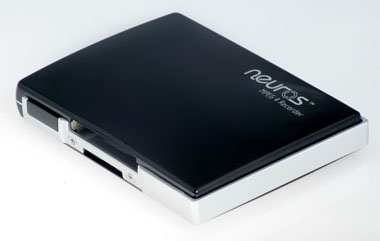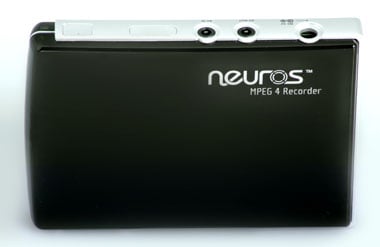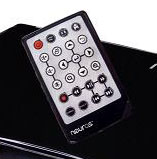Original URL: https://www.theregister.com/2006/02/01/review_neuros_mpeg_recorder_2/
Neuros MPEG 4 Recorder 2
The no-frills PVR is revamped for the PSP and iPod
Posted in Personal Tech, 1st February 2006 16:10 GMT
Review The first incarnation of Neuros' MPEG 4 Recorder proved a handy tool for getting video onto a PDA without having to leave your computer on overnight while it churned through complex re-encoding algorithms. However, it didn't quite hack it as a no-frills PVR, lacking support for the higher resolutions you need for decent playback on a TV, and the ability to program a recording schedule. Neuros is one of those rare companies that not only takes such criticism on board but does something about it, and in this case promptly tweaked the product and re-released it as the Recorder 2...

The look and feel of the unit is the same, but scenting the opportunity provided by Sony's PlayStation Portable, Neuros has dropped the original Recorder's SD card support in favour of a MemoryStick Pro Duo slot. There's a CompactFlash slot too - as before - and Crucial Technology kindly lent Reg Hardware a 4GB card to equip the Recorder 2 with some storage capacity.
The two memory card slots are situated at the front of the device. Round the back are two 3.5mm stereo jacks: one a video input port, the other for video output. There's a power connector too. A flat plastic panel is all that survives of the original recorder's USB 2.0 port, now lost but ironically more useful than before. Neuros is also pitching the device at owners of the fifth-generation, video-playing iPod. Since the Apple machine (unlike the PSP), lacks a memory card slot of its own, recordings have to come via a PC or Mac. Macs certainly don't, and not all PCs provide a memory card slot, so by ditching the Recorder's USB port, Neuros is forcing a lot of folk to buy an external card reader. Once again, Crucial came to my rescue with a dandy-yet-cheap plug-in CF reader.
With the 4GB Crucial CF card installed, I hooked the Recorder 2 up to my DVD player and - since my TV lacks RCA composite-video and audio jacks - my VCR with the two bundled cables. Turning the Recorder 2 on, I found that not only has Neuros bundled a better remote control with it, but it's improved the on-screen interface too.

The screen now presents six 'tabs': Photos, Music, Video Playback, Video Recording, Settings and a File Browser, all identified by icons along the top of the screen. You use the right and left arrow keys on the remote to cycle through them, pressing the Return button to access each tab's items, such as a list of the folders holding videos. The exception, perhaps, is the Video Recording tab, which initially provides a much-reduced live preview of the source. Pressing return replaces the UI with a full-screen preview, overlayed with the time, encoding quality, and so forth. Pressing the remote's menu key brings up a second screen, this time with relevant settings, such as recorded image size and quality, and timed recording schedules. These are not replicated in the general Settings tab.

As before, the recorder offers MP3 playback and photo presentations, but its real focus is video recording, so I tried that first. The UI's video recording 'tab' presents a handy preview of the source, but you have to press Enter on the remote to go into the video recording section in order to call up the appropriate settings panel to choose the encoded video's size and picture quality. There's the usual 320 x 240 resolution on offer, to which the Recorder 2 adds PSP-friendly 368 x 208 (aka WQVGA) - though the device's display resolution is higher than this - and 640 x 480 for TV playback.
It's a little confusing at first, because 640 x 480 recordings are saved in a folder called TV, while all the other formats end up in a folder labelled MVP. When you're ready to start recording, just press the standard red record button. To stop, press the record button again - there's no Stop key.
Going back to the original recorder's limited ability to operate as a PVR, the new model not only sports larger image size, but has a timer facility too. It's not quite TiVo, but it does the job. There are four quality settings: Super Fine, Fine, Normal and Economy. Essentially, they're bit-rate settings for the device's MPEG 4 encoder: 2Mbps, 1Mbps, 768Kbps and 384Kbps, respectively. Switching to either QVGA or WQVGA limits your bit-rate choice to either Normal or Economy - unsurprising, as the PSP can't play back anything higher than 768Kbps. The player also creates the .THM thumbnail files used by the PSP's menu system to display content previews.
The MPEG 4 Recorder defaults to NTSC output, but you can easily switch it to PAL in the Settings tab. Mac users should note that the player nicely ignores metafiles created when its memory card is read by Mac OS X's Finder.
The device's recording results are good, and while anything less than Super Fine doesn't make for an ideal TV experience, at least you can sacrifice visual fidelity to maximise the available storage, if you wish. The only thing I didn't like was the way the frame was cropped when I was recording to WQVGA format, with not only the lower black bar of the letterbox image removed, but some of the picture too.
Video capture results
The following images were all taken from a source set to transmit a 2.35:1 aspect-ratio frame at 4:3.

640 x 480 resolution, SuperFine quality

640 x 480 resolution, Economy quality

320 x 240 resolution, Normal quality

320 x 240 resolution, Economy quality
Video capture results
The following images were all taken from a source set to transmit a 2.35:1 aspect-ratio frame at 4:3.

368 x 208 resolution, Normal quality

368 x 208 resolution, Economy quality
The following image was taken from a source set to transmit a 2.35:1 aspect-ratio frame at 16:9.

368 x 208 resolution, Normal quality
The following images were taken from a source set to transmit a 16:9 aspect-ratio frame at 16:9.

368 x 208 resolution, Normal quality

320 x 240 resolution, Normal quality
Given my TV's aspect ration is 4:3, that's how I have my DVD player set. Switching it to 16:9 mode yielded better results, though not perfect ones, depending on your point of view. Recording from a 16:9 source to WQVGA eliminated the odd cropping, but the 2.35:1 was stretched vertically to fill the 16:9 frame - the classic anamorphic look. My TV can operate in quasi-16:9 mode, and setting it so immediately produced a correct-ratio picture, but as the MPEG 4 file was encoded in anamorphic form, viewing the MPEG 4 file on a computer gave me just the stretched picture. A 16:9 ratio DVD looked less stretched but suffered from some cropping.
Cropped or stretched? Ultimately, it's up to you and how the video looks on your preferred playback device. WQVA produces or eliminates the letterbox look, but you risk losing some of the frame and/or getting a stretched picture.
If that sounds more of a problem than a solution, it's worth bearing in mind that it digitises in real time. Re-encoding a DVD for playback on a mobile device is typically a two-stage process - rip the disc then re-encode the MPEG 2 files - and while it might be a quick process for anyone using a top-of-the-range system, for the rest of us it can be a chore, or something you need to leave running overnight. My system's just under three years old, and while ripping a DVD doesn't take long, converting it to MPEG 4 does. By contrast, with the MPEG 4 Recorder I can record a DVD while I'm watching it. And 'tape' TV shows, too - and for $150, it won't take long to save what I might have spent downloading programmes from iTunes.
As before, Neuros bundles Ulead's VideoToolbox, which provides a handy way of converting MPEG 4 files to other formats and some basic splicing and stitching tools. You'll also find a copy of the open source Core Media Player for Windows Mobile and Palm OS devices: a good move, and an improvement on the previous version which effectively left PDA users - Palm fans in particular - hunting around for something that would play video they'd sync'd across.
Verdict
Neuros' MPEG 4 Recorder was a great product for getting movies and TV shows onto a PDA, and the Recorder 2, with its more widely supported video and audio codecs, PSP-friendly encoding settings, and near-DVD quality TV recording, is a big step forward. It's still not the last word in PVRs, of course, but the new version does a better job than its predecessor.
It's a shame Neuros felt it necessary to drop the unit's USB 2.0 support, particularly since the unit's support for the iPod video format puts Mac and PC connectivity at a premium. Fortunately, USB-based card readers are very cheap these days, but it's still a disappointing omission.
PSP users will be less concerned about that than owners of other mobile devices, and for them the MPEG 4 Recorder 2 costs less than eight pre-recorded UMDs, always a galling purchase when you own the content in other forms, such as DVD. The same goes for anyone who has a fifth-generation iPod - users benefit too. And it also makes a pretty decent VCR replacement. ®